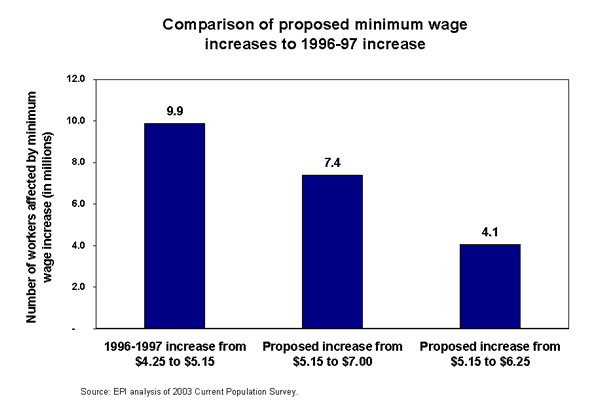See Snapshots Archive.
Snapshot for April 28, 2004.
A long-overdue increase in the minimum wage is needed to restore lost ground
The federal minimum wage protects low-wage workers by establishing an hourly wage floor and strengthens the economy by increasing consumers’ purchasing power. Because the minimum wage is not indexed with inflation, its value erodes each year that the government fails to act, making it more difficult for low-wage workers to make ends meet. Today, a minimum wage employee who works 40 hours a week, 52 weeks a year, earns only $10,712 a year—$5,000 below the 2004 poverty line for a family of three. The current minimum wage is insufficient for low-wage families to meet their most basic needs.
Congress has not increased the minimum wage in more than six years. The last increase raised the minimum wage from $4.25 to $4.75 on October 1, 1996 and to $5.15 on September 1, 1997. Since 1997, inflation and government inaction have eaten away 90% of the value of that increase, returning the minimum wage to a historically low level in terms of purchasing power. The minimum wage has also lost significant ground compared to average hourly earnings in private employment. In the first quarter of 2004, the $5.15 minimum wage was only 33.2% of average hourly earnings ($15.52)—the lowest it has been in more than 50 years.
Recognizing the plight facing low-wage workers, two Senate proposals raising the minimum wage are expected. The first is likely to propose an increase to $7.00 in three stages. An alternate proposal is expected to propose a smaller increase to $6.25 an hour. Unfortunately, neither proposal suggests indexing the minimum wage to increases in the cost of living.
The figure below compares the direct effects of an increase in the minimum wage under these two proposals with the 1996-1997 increase. These “direct” effects only consider workers who earn less than the new minimum wage. The last minimum wage increase in 1996-1997 improved the earnings of 9.9 million workers, or 8.9% of the workforce. It did so without negative employment or economic consequences and can therefore be used as a benchmark for a successful minimum wage package. The impact of both proposals, however, falls far short of the 1996-1997 increase. The $7.00 proposal would raise the wages of 7.4 million workers, or 5.9% of the workforce, while the increase to $6.25 would only raise the wages of 4.1 million workers, or 3.3% of the workforce. More than two-thirds of those who would be affected by a minimum wage increase are adults age 20 and older, and women and minorities would particularly benefit.

Congress should act quickly to pass a generous minimum wage package that will help to lift these families out of poverty. In addition to raising the minimum wage, Congress should also move to index the minimum wage so that the wages of poor working families automatically keep up with the rising cost of living and are not subject to long periods of inaction that push more people into poverty.
Note: The estimates in the figure assume that both proposals are phased-in, with the final step occurring in April 2006. If the actual phase-in dates are sooner (or later), the effect on the workforce will be slightly larger (or smaller). For example, if the $6.25 proposal was fully phased in by July 2004, it would affect 4.4. million workers, or 3.6% of the workforce.
Today’s snapshot was written by EPI Deputy Director of Policy Amy Chasanov and EPI Policy Analyst Jeff Chapman.
